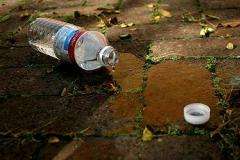Researchers have calculated that the energy required to produce bottled water is up to 2,000 times more than the energy required to produce tap water. Image credit: Wikimedia Commons.
(PhysOrg.com) -- Most people who buy bottled water have access to clean drinking water virtually for free (in the US, tap water costs less than a penny per gallon, on average). Nevertheless, the consumption of bottled water continues to grow, far surpassing the US sales of milk and beer, and second only to soft drinks.
Since world consumption of bottled water has increased by 70% since 2001 to 200 billion liters in 2007, some people have become concerned about the environmental, economical, and social impacts of bottled water. In a recent study, researchers Peter Gleick and Heather Cooley from the Pacific Institute in Oakland, California, have estimated the energy required to produce bottled water, including the energy required to manufacture plastic, fabricate the plastic into bottles, process the water, fill and seal the bottles, transport the bottles, and chill the bottles for use.
Combining all the energy input totals, Gleick and Cooley found that producing bottled water requires between 5.6 and 10.2 million joules of energy per liter, depending on transportation factors (a typical personal-sized water bottle is about 0.5 liters). That’s up to 2,000 times the energy required to produce tap water, which costs about 0.005 million joules per liter for treatment and distribution.
In 2007, US consumers purchased more than 33 billion liters of bottled water, or 110 liters (30 gallons) per person. The total energy required to produce 33 billion liters is equivalent to 32-54 million barrels of oil (although not all the energy used comes from oil). Energy to produce bottled water accounts for about one-third of one percent of total US energy consumption.
To break down the energy requirements, Gleick and Cooley found that producing the plastic bottles and transporting the bottles greatly dominated the energy input. Most single-use plastic water bottles are made out of polyethylene terephthalate (PET), recognized in the US by the recycling code “1” imprinted on the bottle. Large containers are more likely made of polycarbonate, which requires about 40% more energy to produce than bottle-grade PET. Although some companies are experimenting with producing lightweight bottles, the researchers calculated that the manufacturing cost of PET is about 4 million joules of energy per typical 1-liter PET bottle weighing 38 grams, and the cap weighing 2 grams. Even though using recycled materials could lead to some energy savings, almost all plastic bottles for water are currently made from virgin PET.
“Our previous work had suggested that bottled water production was an energy-intensive process, but we were surprised to see that the energy equivalent of nearly 17 million barrels of oil are required to produce the PET bottles alone,” Cooley told PhysOrg.com.
Transportation costs vary depending on the distance and mode of transport, and both factors depend on the type of bottled water. There are two main kinds of bottled water in the US: “spring water,” which comes from an underground spring, and accounts for 56% of US sales; and “purified water,” which is municipal tap water that has received further treatment, and accounts for 44% of US sales. Spring water can only be derived from certain locations, while purified water can be produced locally. (In the US, Nestlé is the largest producer of spring water, while Coca-Cola (Dasani), Pepsi (Aquafina) and Nestlé (Pure Life) account for most of the country’s purified water sales.)
In their analysis, Gleick and Cooley evaluated three different transportation scenarios, and calculated the energy requirements per liter of bottled water. For purified water distributed locally by truck within Los Angeles, the total transportation energy is about 1.4 million joules per liter. In the second situation, spring water shipped from Fiji (such as Fiji Spring Water) across the Pacific to Los Angeles, and then delivered locally by truck, requires about 4 million joules per liter for transportation. Third, spring water transported by truck from French springs (such as Evian) to French sea ports, then shipped across the Atlantic, transported by train from the east coast to Los Angeles, and then delivered locally by truck has a transportation energy cost of about 5.8 million joules per liter. For the two spring water scenarios, the transportation energy equaled (in the case of Fiji) or exceeded (in the case of France) the energy required to produce the bottle.
The energy required for processing, bottling, sealing, labeling, and refrigeration were much smaller than the energy for making the bottles and transporting them. With this data, the researchers hope that future studies will have the ability to make specific estimates for different scenarios, and possibly find ways to cut energy costs.
“With the US consumption of bottled water exceeding 33 billion liters a year, and with intensifying efforts to reduce energy use and greenhouse gas emissions, these data should help identify ways to reduce the energy costs of bottled water and may help consumers themselves make more environmentally sustainable choices,” Cooley said.
More information: Gleick, P.H. and Cooley, H.S. “Energy implications of bottled water.” Environmental Research Letters 4 (2009) 014009 (6pp).
Copyright 2009 PhysOrg.com.
All rights reserved. This material may not be published, broadcast, rewritten or redistributed in whole or part without the express written permission of PhysOrg.com.



















